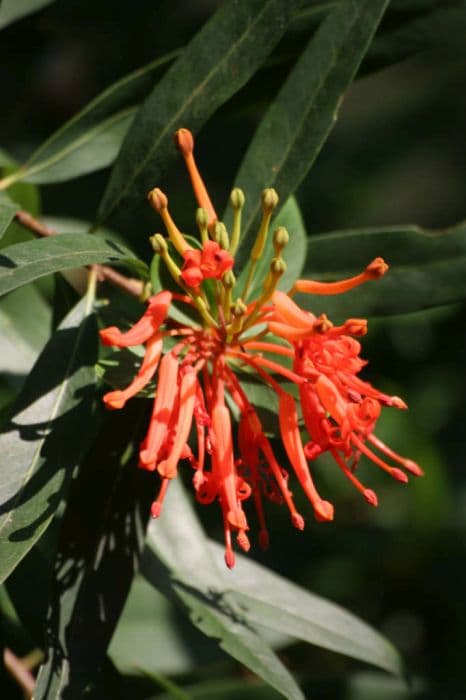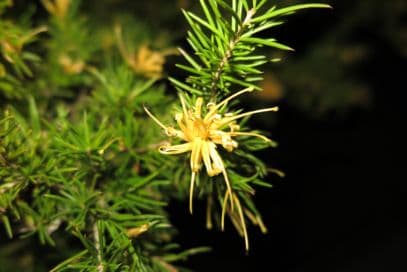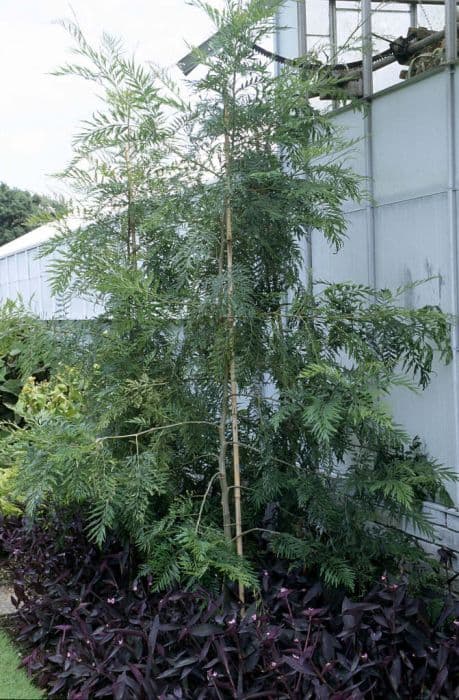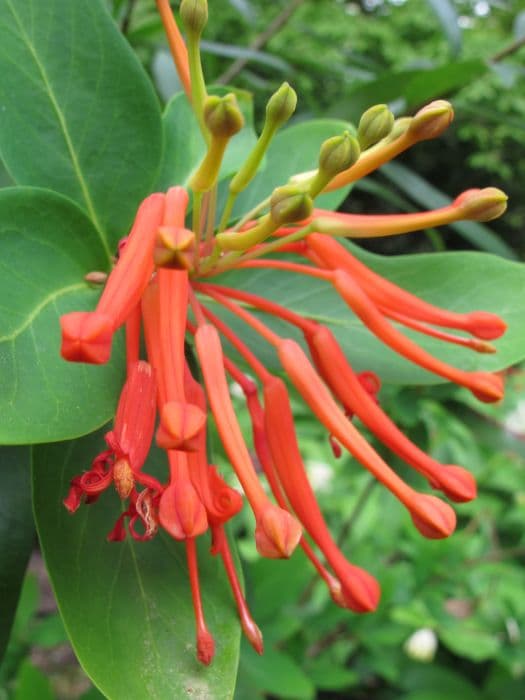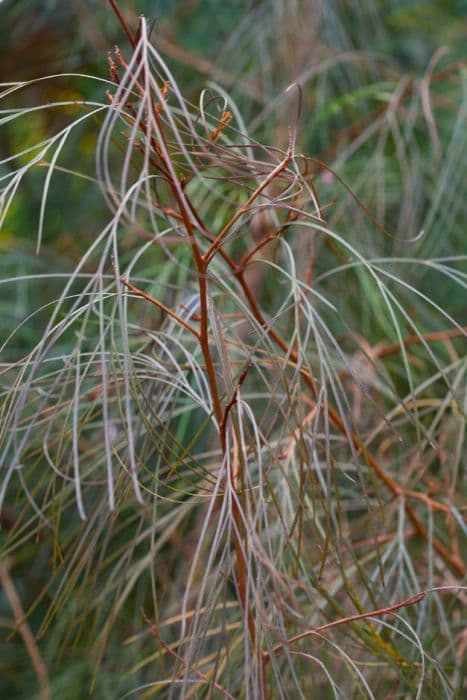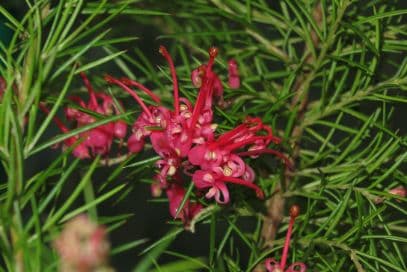Royal Grevillea Grevillea victoriae

ABOUT
The Royal Grevillea, commonly known as Grevillea victoriae, is a striking Australian native plant admired for its ornamental characteristics. The plant has a robust and evergreen foliage, consisting of narrow, oblong leaves with a rich dark green hue on the top and a slightly paler underside, often with a hairy texture. The uniquely textured leaves give the plant a lush and dense appearance. One of the most distinctive features of the Royal Grevillea is its flowers. The blooms are a vibrant orange-red to deep red, and they appear in clusters that resemble toothbrush bristles. These intricate, tubular flowers are rich in nectar and attract a myriad of pollinators, including birds and insects, providing an animated and colorful display in the garden. The Royal Grevillea's blossoms stand out against its foliage and can create a year-round floral interest, especially since the plant is known to flower over a long period. Each individual flower has a curved appearance, which, along with the bold color, adds to the visual impact of the plant. Following the flowering period, the Royal Grevillea may produce a fruit, which typically consists of a woody follicle. Overall, the Royal Grevillea's combination of striking red flowers, dark-green foliage, and the lively presence of pollinators make it a fascinating and attractive plant for garden enthusiasts looking for a splash of color and natural beauty.
About this plant
 Names
NamesFamily
Proteaceae
Synonyms
Royal Grevillea, Victoria Grevillea
Common names
Grevillea victoriae.
 Toxicity
ToxicityTo humans
Royal grevillea is not typically known for being a highly toxic plant to humans. However, as with many plants, it can cause irritation or allergic reactions in some individuals. If sap from the royal grevillea comes into contact with skin, it can sometimes cause dermatitis or a skin rash. Ingesting parts of the plant is not generally considered life-threatening, but it could potentially cause mild gastrointestinal upset such as nausea or vomiting for those with sensitivities. It is always advisable to avoid eating parts of ornamental plants due to the risk of individual allergic reactions or the presence of compounds that could be harmful in larger amounts.
To pets
For pets, royal grevillea is not commonly recognized as a toxic plant. Nonetheless, ingestion of plant parts by pets such as dogs or cats could lead to similar symptoms as in humans, including gastrointestinal upset like vomiting or diarrhea, especially if the animal is not accustomed to the plant or has a particular sensitivity to it. It is always best to prevent pets from chewing on any garden plants, as individual reactions can vary, and some pets may have more severe responses depending on their size, the amount ingested, and their overall health. If you suspect your pet has ingested any part of the royal grevillea and is showing symptoms, it is best to consult a veterinarian.
 Characteristics
CharacteristicsLife cycle
Perennials
Foliage type
Evergreen
Color of leaves
Green
Flower color
Orange-red
Height
6-10 feet (1.8-3 meters)
Spread
6-10 feet (1.8-3 meters)
Plant type
Shrub
Hardiness zones
7
Native area
Australia
Benefits
 General Benefits
General Benefits- Attracts Wildlife: Grevillea victoriae, commonly known as Royal Grevillea, provides nectar and shelter for birds, bees, and butterflies, enhancing biodiversity.
- Drought Tolerance: Royal Grevillea is highly adaptable to dry conditions, making it suitable for xeriscaping and water-wise gardens.
- Aesthetic Appeal: With its striking orange to red flowers and attractive foliage, Royal Grevillea adds color and visual interest to landscapes.
- Low Maintenance: This plant typically requires minimal care, pruning, and feeding, making it ideal for gardeners seeking low-maintenance options.
- Erosion Control: The plant's root system can help stabilize soil and control erosion on slopes or in areas prone to soil degradation.
- Adaptability: Royal Grevillea can thrive in a variety of soil types and climatic conditions, making it versatile for different garden settings.
- Privacy Screening: When planted in groups, Royal Grevillea can act as a natural screen, providing privacy and reducing noise pollution.
 Medical Properties
Medical Properties- This plant is not used for medical purposes.
 Air-purifying Qualities
Air-purifying QualitiesThis plant is not specifically known for air purifying qualities.
 Other Uses
Other Uses- Floral Arrangements: The stunning flowers of the Royal Grevillea can be used in both fresh and dried floral arrangements due to their unique beauty and longevity.
- Textile Dyes: The color from the flowers of the Royal Grevillea can be extracts to produce natural dyes for coloring fabrics.
- Bird Attractant: Gardeners can plant Royal Grevillea to attract nectar-feeding birds, providing natural bird watching opportunities.
- Erosion Control: Royal Grevillea can be used in landscapes to help stabilize soil and prevent erosion on slopes.
- Microclimate Creation: By planting Royal Grevillea, gardeners can create microclimates that offer shade and modify local temperature extremes.
- Windbreaks: The Royal Grevillea's dense foliage can serve as windbreaks, sheltering gardens and outdoor living spaces from strong winds.
- Privacy Screening: The shrubby nature of the Royal Grevillea makes it an excellent choice for natural privacy screens in decorative gardens.
- Education: The plant is often used in botanical studies and horticultural classes to teach plant identification and Australian native flora characteristics.
- Photography: The Royal Grevillea is photogenic and a popular subject for botanical photographers and nature enthusiasts.
- Ecological Studies: Royal Grevillea's role in the ecosystem, attracting pollinators and birds, is a point of study for ecologists and conservationists.
Interesting Facts
 Feng Shui
Feng ShuiThe Royal grevillea is not used in Feng Shui practice.
 Zodiac Sign Compitability
Zodiac Sign CompitabilityThe Royal grevillea is not used in astrology practice.
 Plant Symbolism
Plant Symbolism- Resilience: The Grevillea victoriae, commonly known as the Royal Grevillea, is a hardy plant that thrives in poor soils and exposed conditions, representing the ability to endure and flourish despite challenges.
- Diversity: With its numerous cultivars and variety of forms, the Royal Grevillea symbolizes the beauty of diversity and the importance of variety in nature and life.
- Attractiveness: The bright and intricate flowers of the Royal Grevillea are known to attract birds and other wildlife, symbolizing allure and the power to draw in others.
- Adaptability: Grevillea victoriae's capacity to adapt to various climates and conditions represents flexibility and the need to adjust to changing environments.
 Water
WaterThe Royal Grevillea should be watered deeply, ensuring that the soil is moist, but well-drained. In the summer, watering approximately every week with around 1-2 gallons of water may be necessary, depending on the climate and soil dryness. During the cooler months, reduce the frequency to every 2-3 weeks, as the plant is less tolerant of waterlogged conditions. Always check the top few inches of soil for dryness before watering again.
 Light
LightRoyal Grevillea thrives in full sun, where it can receive direct sunlight for most of the day. The best spot for this plant is in a south-facing position where it can enjoy uninterrupted light. Partial shade is also acceptable, particularly in extremely hot climates where some afternoon shade can help prevent leaf scorch.
 Temperature
TemperatureRoyal Grevillea prefers temperatures ranging between 50°F and 80°F, which are ideal for its growth. It can withstand minimum temperatures of around 20°F, but frost can damage the plant. It’s important to protect it from harsh winter conditions by providing a sheltered position or using frost cloth.
 Pruning
PruningPrune the Royal Grevillea to maintain shape and encourage denser growth. Light pruning is best done in the spring or after flowering by removing dead or weak stems and shaping the plant. Regular pruning, especially of spent flowers, can also promote additional blooming cycles.
 Cleaning
CleaningAs needed
 Soil
SoilRoyal grevillea thrives in well-draining, slightly acidic to neutral soil with a pH of 5.5-7. A mix of loam, sand, and peat moss is ideal, ensuring good aeration and drainage. Fertilize sparingly as they are sensitive to phosphorus.
 Repotting
RepottingRoyal grevillea should be repotted every 2-3 years or when rootbound. Use a pot slightly larger than the former one, as a too-large pot can lead to water retention issues.
 Humidity & Misting
Humidity & MistingRoyal grevillea prefers moderate humidity but is adaptable to lower humidity levels. Avoid excessive humidity to prevent fungal diseases.
 Suitable locations
Suitable locationsIndoor
Place Royal grevillea in bright, indirect light indoors.
Outdoor
Plant Royal grevillea in full sun to partial shade outside.
Hardiness zone
7-10 USDA
 Life cycle
Life cycleGrevillea victoriae, commonly known as Royal Grevillea, begins its life as a seed, often requiring exposure to smoke or heat to break dormancy, a process known as serotiny (however, some individuals may germinate without such triggers). Once germinated, the seedling grows, developing a root system and its first set of leaves. As it matures, the plant continues to grow foliage and its distinctive, fern-like leaves become more pronounced. During its adult stage, Grevillea victoriae produces vibrant orange to red flowers, usually in winter through to spring, attracting birds and insects for pollination. Seeds develop and are held within woody fruits until they are ready to be dispersed, occasionally by fire which again stimulates seed release and germination. The plant continues to grow and can live for many years, continuously flowering each season while gradually increasing in size.
 Propogation
PropogationPropogation time
Summer to autumn
Grevillea victoriae, commonly known as Royal Grevillea, is best propagated through semi-hardwood cuttings. This method typically takes place in late summer. Cuttings should be 4 to 6 inches (10 to 15 centimeters) long, taken from the current season's growth. The lower leaves are removed and the base of the cutting is dipped in rooting hormone to enhance root development. The cuttings are then inserted into a well-draining potting mix, ensuring that the leaf nodes, where root growth is encouraged, are below the surface. The pot should be kept in a warm, sheltered environment, ideally using a propagation mat to maintain soil warmth, and the soil should be kept moist but not waterlogged until roots have developed. This process usually takes several weeks.
